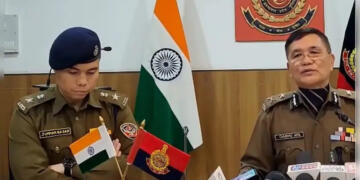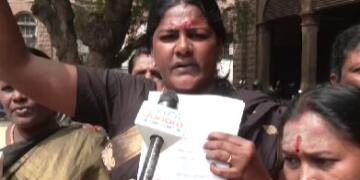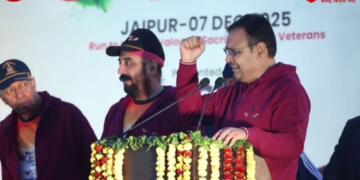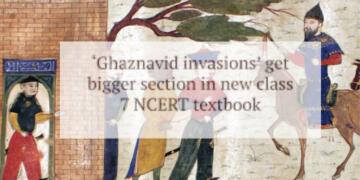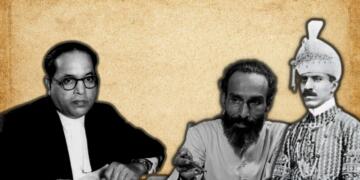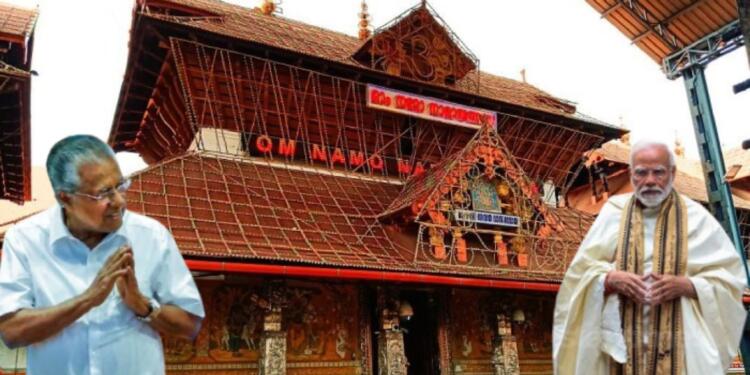After Sabarimala Lord Ayyappa temple, the Communist government and its ecosystem have come after the Guruvayur temple in Kerala. For this, it is launching a smear campaign against the Mandir tradition and it is shooting off from the shoulders of “reformists”. The onslaught on the rich and Sanatan tradition of the Guruvayur temple is being layered under the garb of “progressive” debate of reform vs tradition.
For those unversed, like many revered Hindu temples and based on the energy, legacy, and ritualistic traditions among host of other scripture based reasons, the Guruvayur temple has been following a sacrosanct tradition. In simplistic terms, the devotees have to follow the tradition of shirtless entry in the temple premises. Even Prime Minister Narendra Modi and his security delegations had to abide by the sanctity of the temple’s tradition where they had gone willingly to take blessings of Lord Vishnu ji. Now, this very tradition is under attack in the garb that it furthers “casteism”.
The grave and brazen charge of “casteism” against an eon old tradition of the Hindu temple was leveled in the presence of head of the Communist government, Pinarayi Vijayan. Currently, he is facing the heat for giving contentious remarks against Sanatan Dharma in which he linked Sanatan Dharma with casteism.
Now, in the presence of Communist leaders, whose deranged take on religion, especially against Sanatan Dharma is an open secret, the issue of Guruvayur temple’s tradition was raked up by ‘Satchindananda Swamy of Shivagiri Mutt’.
In presence of Kerala CM Pinarai Vijayan, Satchindananda Swamy sermonised for giving away the tradition of shirtless entry in the temple, referring to it as a residue of casteism.
For those unversed, it may sound to be a voice from intra-tradition because of the ‘Swamy’ title, the fact is Shivagiri Mutt was founded by Narayana Guru who is considered a social reformist in Kerala. Guru’s philosophy is considered to be rooted in Advaita Vedanta. The doctrine emphasises “non-duality,” asserting that the “ultimate reality” or “Brahman” is singular and indivisible, and that the “individual self” or “Atman” is unified with this universal essence. He advocated his philosophy with the message of “One Caste, One Religion, One God for Man,” to challenge societal norms. He promoted the opening of consecrated temples to people of all castes.
However, under his disciples, a political slugfest against the Guruvayur temple and all similar Hindu temples has been raked up to shield Communist leader Vijayan’s deranged take on Narayana Guru’s association with Sanatan Dharma and an assault on the latter. The timing is sufficient enough to establish the fact that why the issue is picked up for debate now.
Nonetheless, when the matter is up for discussion, many aspects would go to test now, prominent among them is caste.
The casteist tag has been derived from the earlier struggle in 1982 when an alleged scuffle broke out between Shree Narayana Guru’s disciple Swamy Ananda Teerthan and those serving free meals after the former refused to remove the upper garment.
As per the details of the alleged incident, it was claimed that the scuffle broke out because the meal was Brahmain Oottu and it was being served only to Brahmins. While so-called social reformists have an axe to grind with the devotees and provoke them on multiple reasons, the alleged discrimination with Non-Brhamins was catered to. Consequently, when the matter escalated, Brahmin Oottu was abolished and it was replaced with a new set up of meals for all.
The temple accepted the decision and made it a tradition to serve all but the fact of the matter is Ananda Teertham was himself a Konkani Brahmin and was no shudra. So, the communist trope of Brahmin vs Non-Brahmin, Brahmin supremacy/hegemony, Brahminicial patriarchy and the boogie of continuation of Brahmin atrocities on Non-Brahmins, Dalits and Tribals in particular, doesn’t hold waters even in the alleged 1982 incident.
Nonetheless, since all this relates to History, it is a matter of investigation if the meal was only served to Brahmins or only that meal ‘Brahmin Oottu’ was served to brahmins. There is a stark difference in both.
Sanatan texts find mention of Brahma bhoj which is no welfare scheme but a traditional meal offered to brahmins, not clergy (emphasis needed), and out of server’s choice not brahmins’ demand. The purpose of such a brahmin meal is not welfare feeding but holds a cultural significance.
Hence, the interference in any such practice should have gone through the investigation into the religious texts and might fall outside the purview of the government.
But the government and its controlled board, governing the temple didn’t even try to go to that extent just to please a section with unwarranted demands.
Nonetheless, the question may still prevail why even have a different meal. This question finds convergence into recent controversy. Here, it is mandatory to revisit the fact that Ananda Teerth claimed he was asked to remove upper garment to prove that he was not a non-Brahmin.
Even after taking into consideration that the oottu was for brahmins only but even after 20 years down the line with furthered modernity, it is bizzare to think that a brahmin identity could have been known only by the yagyopavit or janeu.
The shiksha sutra on the head is sufficient for that matter. If anyone argues that shikha sutra can be grown by anyone, then the janeu is also not monopolised by brahmins, in fact three of the four varnas are entitled by shastras to wear janeu. So the question here is how Janeu can prove someone is brahmin. Nevertheless, there is a significant number of brahmins today, who have relinquished janeu, how would they prove their brahmanical identity.
Simply put, predominantly it’s not about caste but about tradition and Brahmins’ involvement is used as a pretext to call anything casteist.
The only feature that must be taken into consideration should be tradition. In recent controversy, Satchisanand claimed that shirtless tradition to enter temples is a casteist residue because there is no mention of such a thing in scriptures and the only thing that matters in temples is the feeling of devotee.
Both the premises of the argument are baseless. Firstly, clothes or vastras play a crucial role secondly, the temple tradition is predominating.
The reason that such arguments flare up is because of the lack of understanding. Most people think that temples are a place where a murt (murti) is installed and people go to see it, which is utter rubbish.
A deity in a temple is consecrated through pran pratistha and is believed to have a soul in it. This makes a deity completely different from any other murt installed anywhere, let’s say home.
So when a person performs any holy task, be it puja, dhyan, japa and darshan among others, he has to make a vow (sankalp). This sankalp and the process, attire are precisely mentioned in our scriptures.
The shirt or any modern cloth for that matter is stitched and is banned to perform such tasks. In Mahabharata, there is a shloka which states: न स्यूते न दगधेन पारक्येन् विशेषतः| मूषिकोत्कीर्ण जीर्णेन कर्म कुर्याद्विचक्षणः||
This translates to, “Any religious task can not be performed by wearing clothes that are stitched, burnt, eaten by mice or worn by others before.”
It busts both the arguments of Satchidananda but on the question of feelings of devotee, indeed it plays a key and central role but what about public morality? As per his argument, any person with shorts would also get a free pass as there is no device to check the feelings.
Pragmatically, attire creates a line which is not crossed by those who have faith in temple and deity and who feel an urge of darshan over the choice of what they would wear or how they look.
Besides, it is also quite hilarious to see that people favouring Satchidananda have previously voiced for plurality and diversity across the country. The communists and the opposition bloc, as a whole, has often indulged in hate-mongering against Hindi, Sanatan Dharma, Hindu rashtra, One Nation One Election etc, under the preposterous trope that they want to crush diversity and impose uniformity. Contrarily, in case of temples, they want to standardise over the individualistic traditions of the revered temples, which has its own rationale, and scriptural backing.
Temples across India follow their own customs and traditions which make them vibrant. People from across North, Northeast and West India travel to the southern part of India and embrace the vashti or mundu cheerfully. Not even once, a feeling of adversity comes to their mind.
For sure there is no place for racial, caste-based discrimination at any place. But at any instance, it must be probed whether a custom is intentionally discriminatory or is actually a tradition.
Secondly, this must also be understood that temples are no public places while they may be open to the public. Their rights to practise and profess their religion and their custom is constitutionally protected. Any attempt to meddle in their affairs would be a breach and must not be accepted on moral grounds.
Also Read: This Week in Focus: These Steps Are Necessary To Avoid Another Atul Subhash Tragedy
The current issue is raked up by those who lack understanding, are politically motivated, and are essentially not the ones who have faith in the particular sect which is under consideration. And hence, morally and logically their opinion holds lower esteem than a common individual who irrespective of caste has faith in Guruvayur and other Hindu temples.
Now it lies on the shoulders of the stakeholders to quote the scriptures to preserve century long traditions which are inherently and by core not discriminatory. Failing which could create a ripple effect that would rupture the very fabric of India’s civilisational and traditional virtue. And make no mistake, no caste upliftment would be done even after that because essentially, the so-called path of upliftment is being taken where there is no inherent discrimination.


